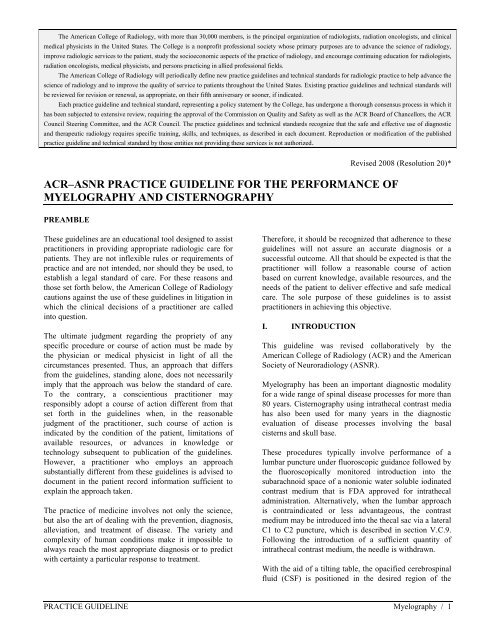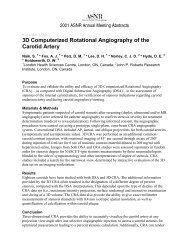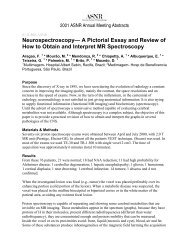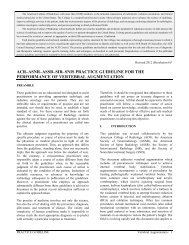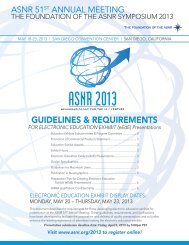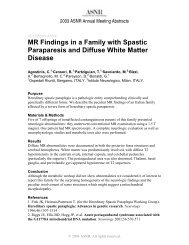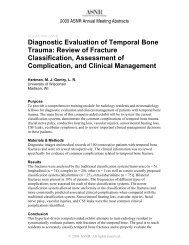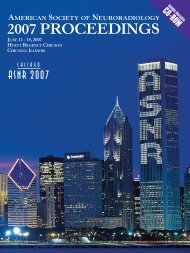acr–asnr practice guideline for the performance of myelography and ...
acr–asnr practice guideline for the performance of myelography and ...
acr–asnr practice guideline for the performance of myelography and ...
You also want an ePaper? Increase the reach of your titles
YUMPU automatically turns print PDFs into web optimized ePapers that Google loves.
The American College <strong>of</strong> Radiology, with more than 30,000 members, is <strong>the</strong> principal organization <strong>of</strong> radiologists, radiation oncologists, <strong>and</strong> clinicalmedical physicists in <strong>the</strong> United States. The College is a nonpr<strong>of</strong>it pr<strong>of</strong>essional society whose primary purposes are to advance <strong>the</strong> science <strong>of</strong> radiology,improve radiologic services to <strong>the</strong> patient, study <strong>the</strong> socioeconomic aspects <strong>of</strong> <strong>the</strong> <strong>practice</strong> <strong>of</strong> radiology, <strong>and</strong> encourage continuing education <strong>for</strong> radiologists,radiation oncologists, medical physicists, <strong>and</strong> persons practicing in allied pr<strong>of</strong>essional fields.The American College <strong>of</strong> Radiology will periodically define new <strong>practice</strong> <strong>guideline</strong>s <strong>and</strong> technical st<strong>and</strong>ards <strong>for</strong> radiologic <strong>practice</strong> to help advance <strong>the</strong>science <strong>of</strong> radiology <strong>and</strong> to improve <strong>the</strong> quality <strong>of</strong> service to patients throughout <strong>the</strong> United States. Existing <strong>practice</strong> <strong>guideline</strong>s <strong>and</strong> technical st<strong>and</strong>ards willbe reviewed <strong>for</strong> revision or renewal, as appropriate, on <strong>the</strong>ir fifth anniversary or sooner, if indicated.Each <strong>practice</strong> <strong>guideline</strong> <strong>and</strong> technical st<strong>and</strong>ard, representing a policy statement by <strong>the</strong> College, has undergone a thorough consensus process in which ithas been subjected to extensive review, requiring <strong>the</strong> approval <strong>of</strong> <strong>the</strong> Commission on Quality <strong>and</strong> Safety as well as <strong>the</strong> ACR Board <strong>of</strong> Chancellors, <strong>the</strong> ACRCouncil Steering Committee, <strong>and</strong> <strong>the</strong> ACR Council. The <strong>practice</strong> <strong>guideline</strong>s <strong>and</strong> technical st<strong>and</strong>ards recognize that <strong>the</strong> safe <strong>and</strong> effective use <strong>of</strong> diagnostic<strong>and</strong> <strong>the</strong>rapeutic radiology requires specific training, skills, <strong>and</strong> techniques, as described in each document. Reproduction or modification <strong>of</strong> <strong>the</strong> published<strong>practice</strong> <strong>guideline</strong> <strong>and</strong> technical st<strong>and</strong>ard by those entities not providing <strong>the</strong>se services is not authorized.ACR–ASNR PRACTICE GUIDELINE FOR THE PERFORMANCE OFMYELOGRAPHY AND CISTERNOGRAPHYRevised 2008 (Resolution 20)*PREAMBLEThese <strong>guideline</strong>s are an educational tool designed to assistpractitioners in providing appropriate radiologic care <strong>for</strong>patients. They are not inflexible rules or requirements <strong>of</strong><strong>practice</strong> <strong>and</strong> are not intended, nor should <strong>the</strong>y be used, toestablish a legal st<strong>and</strong>ard <strong>of</strong> care. For <strong>the</strong>se reasons <strong>and</strong>those set <strong>for</strong>th below, <strong>the</strong> American College <strong>of</strong> Radiologycautions against <strong>the</strong> use <strong>of</strong> <strong>the</strong>se <strong>guideline</strong>s in litigation inwhich <strong>the</strong> clinical decisions <strong>of</strong> a practitioner are calledinto question.The ultimate judgment regarding <strong>the</strong> propriety <strong>of</strong> anyspecific procedure or course <strong>of</strong> action must be made by<strong>the</strong> physician or medical physicist in light <strong>of</strong> all <strong>the</strong>circumstances presented. Thus, an approach that differsfrom <strong>the</strong> <strong>guideline</strong>s, st<strong>and</strong>ing alone, does not necessarilyimply that <strong>the</strong> approach was below <strong>the</strong> st<strong>and</strong>ard <strong>of</strong> care.To <strong>the</strong> contrary, a conscientious practitioner mayresponsibly adopt a course <strong>of</strong> action different from thatset <strong>for</strong>th in <strong>the</strong> <strong>guideline</strong>s when, in <strong>the</strong> reasonablejudgment <strong>of</strong> <strong>the</strong> practitioner, such course <strong>of</strong> action isindicated by <strong>the</strong> condition <strong>of</strong> <strong>the</strong> patient, limitations <strong>of</strong>available resources, or advances in knowledge ortechnology subsequent to publication <strong>of</strong> <strong>the</strong> <strong>guideline</strong>s.However, a practitioner who employs an approachsubstantially different from <strong>the</strong>se <strong>guideline</strong>s is advised todocument in <strong>the</strong> patient record in<strong>for</strong>mation sufficient toexplain <strong>the</strong> approach taken.The <strong>practice</strong> <strong>of</strong> medicine involves not only <strong>the</strong> science,but also <strong>the</strong> art <strong>of</strong> dealing with <strong>the</strong> prevention, diagnosis,alleviation, <strong>and</strong> treatment <strong>of</strong> disease. The variety <strong>and</strong>complexity <strong>of</strong> human conditions make it impossible toalways reach <strong>the</strong> most appropriate diagnosis or to predictwith certainty a particular response to treatment.There<strong>for</strong>e, it should be recognized that adherence to <strong>the</strong>se<strong>guideline</strong>s will not assure an accurate diagnosis or asuccessful outcome. All that should be expected is that <strong>the</strong>practitioner will follow a reasonable course <strong>of</strong> actionbased on current knowledge, available resources, <strong>and</strong> <strong>the</strong>needs <strong>of</strong> <strong>the</strong> patient to deliver effective <strong>and</strong> safe medicalcare. The sole purpose <strong>of</strong> <strong>the</strong>se <strong>guideline</strong>s is to assistpractitioners in achieving this objective.I. INTRODUCTIONThis <strong>guideline</strong> was revised collaboratively by <strong>the</strong>American College <strong>of</strong> Radiology (ACR) <strong>and</strong> <strong>the</strong> AmericanSociety <strong>of</strong> Neuroradiology (ASNR).Myelography has been an important diagnostic modality<strong>for</strong> a wide range <strong>of</strong> spinal disease processes <strong>for</strong> more than80 years. Cisternography using intra<strong>the</strong>cal contrast mediahas also been used <strong>for</strong> many years in <strong>the</strong> diagnosticevaluation <strong>of</strong> disease processes involving <strong>the</strong> basalcisterns <strong>and</strong> skull base.These procedures typically involve per<strong>for</strong>mance <strong>of</strong> alumbar puncture under fluoroscopic guidance followed by<strong>the</strong> fluoroscopically monitored introduction into <strong>the</strong>subarachnoid space <strong>of</strong> a nonionic water soluble iodinatedcontrast medium that is FDA approved <strong>for</strong> intra<strong>the</strong>caladministration. Alternatively, when <strong>the</strong> lumbar approachis contraindicated or less advantageous, <strong>the</strong> contrastmedium may be introduced into <strong>the</strong> <strong>the</strong>cal sac via a lateralC1 to C2 puncture, which is described in section V.C.9.Following <strong>the</strong> introduction <strong>of</strong> a sufficient quantity <strong>of</strong>intra<strong>the</strong>cal contrast medium, <strong>the</strong> needle is withdrawn.With <strong>the</strong> aid <strong>of</strong> a tilting table, <strong>the</strong> opacified cerebrospinalfluid (CSF) is positioned in <strong>the</strong> desired region <strong>of</strong> <strong>the</strong>PRACTICE GUIDELINE Myelography / 1
spinal subarachnoid space (lumbar, thoracic, or cervical)or in <strong>the</strong> intracranial basal cisterns, <strong>and</strong> appropriateradiographic/fluoroscopic (conventional myelogram)<strong>and</strong>/or computed tomographic (CT) myelogram orcisternogram images are obtained.Institutions <strong>of</strong>fering <strong>myelography</strong> should insist ondocumentation <strong>of</strong> appropriate training, demonstratedcompetence, <strong>and</strong> maintenance <strong>of</strong> skills <strong>for</strong> all physicianswho receive privileges to per<strong>for</strong>m <strong>the</strong>se procedures.II.INDICATIONSAlthough <strong>myelography</strong> <strong>and</strong> cisternography have largelybeen superseded by <strong>the</strong> development <strong>of</strong> high resolutionCT <strong>and</strong> magnetic resonance imaging (MRI), <strong>the</strong>re remain<strong>the</strong> following indications <strong>for</strong> <strong>the</strong>se procedures:1. Demonstration <strong>of</strong> <strong>the</strong> site <strong>of</strong> a cerebrospinal fluidleak (postlumbar puncture headache, postspinalsurgery headache, rhinorrhea, or otorrhea).2. Surgical planning, especially in regard to <strong>the</strong>nerve roots.3. Radiation <strong>the</strong>rapy planning.4. Diagnostic evaluation <strong>of</strong> spinal or basal cisternaldisease.5. Nondiagnostic MRI studies <strong>of</strong> <strong>the</strong> spine or skullbase.6. Poor correlation <strong>of</strong> physical findings with MRIstudies.7. Use <strong>of</strong> MRI precluded because <strong>of</strong>:a. Claustrophobiab. Technical issues, e.g., patient sizec. Safety reasons, e.g., pacemakerd. Surgical hardwareFor <strong>the</strong> pregnant or potentially pregnant patient, see <strong>the</strong>ACR Practice Guideline <strong>for</strong> Imaging Pregnant orPotentially Pregnant Adolescents <strong>and</strong> Women withIonizing Radiation.III.A. PhysicianQUALIFICATIONS ANDRESPONSIBILITIES OF PERSONNELCertification in Radiology or Diagnostic Radiology by <strong>the</strong>American Board <strong>of</strong> Radiology, <strong>the</strong> American OsteopathicBoard <strong>of</strong> Radiology, <strong>the</strong> Royal College <strong>of</strong> Physicians <strong>and</strong>Surgeons <strong>of</strong> Canada, or <strong>the</strong> Collège des Médecins duQuébec, <strong>and</strong> <strong>the</strong> per<strong>for</strong>mance <strong>of</strong> <strong>myelography</strong> withacceptable success <strong>and</strong> complication rates.orCompletion <strong>of</strong> a residency or fellowship training programapproved by <strong>the</strong> Accreditation Council <strong>for</strong> GraduateMedical Education (ACGME), <strong>the</strong> Royal College <strong>of</strong>Physicians <strong>and</strong> Surgeons <strong>of</strong> Canada (RCPSC), <strong>the</strong> Collègedes Médecins du Québec, or <strong>the</strong> American OsteopathicAssociation (AOA) to include evidence <strong>of</strong> training <strong>and</strong>competency in <strong>myelography</strong>. Adequate training shouldinclude <strong>the</strong> per<strong>for</strong>mance <strong>of</strong> a sufficient number <strong>of</strong>myelographic procedures to become facile in <strong>the</strong>technique.<strong>and</strong>Instruction in all <strong>of</strong> <strong>the</strong> following areas should besubstantiated by <strong>the</strong> director <strong>of</strong> <strong>the</strong> training program:1. Anatomy, physiology, <strong>and</strong> pathophysiology <strong>of</strong><strong>the</strong> central <strong>and</strong> peripheral nervous systems.2. Physics <strong>of</strong> ionizing radiation, including anunderst<strong>and</strong>ing <strong>of</strong> its production, detection, <strong>and</strong>risks, <strong>and</strong> <strong>of</strong> techniques to minimize radiationexposure.3. Pharmacology <strong>and</strong> dosage <strong>of</strong> contrast media usedin <strong>myelography</strong>. (Use <strong>of</strong> only those agentsapproved <strong>for</strong> intra<strong>the</strong>cal use should beemphasized.)4. Indications <strong>for</strong> <strong>myelography</strong> <strong>and</strong> cisternography.5. Preprocedural assessment <strong>of</strong> <strong>the</strong> patient.6. Conduct <strong>of</strong> <strong>the</strong> myelographic examination. Thisincludes spinal puncture, patient positioning, <strong>and</strong>fluoroscopic <strong>and</strong> filming techniques.7. Conduct <strong>of</strong> <strong>the</strong> postmyelogram CT examination.This includes timing, patient positioning, <strong>and</strong>technical factors.8. Postprocedural patient management, especially<strong>the</strong> recognition <strong>and</strong> initial management <strong>of</strong>complications.9. Interpretation <strong>of</strong> lumbar, thoracic, <strong>and</strong> cervicalmyelograms <strong>and</strong> cisternograms, as well asinterpretation <strong>of</strong> postmyelogram CT scans.10. Contraindications to <strong>myelography</strong>.11. Knowledge <strong>of</strong> <strong>the</strong> drugs that can increase risk <strong>of</strong>myelographic adverse events.Maintenance <strong>of</strong> CompetenceTo maintain privileges, physicians must per<strong>for</strong>m asufficient number <strong>of</strong> myelographic procedures to maintain<strong>the</strong>ir skills with acceptable success <strong>and</strong> complicationrates.Continuing Medical EducationContinuing education should be in accordance with <strong>the</strong>ACR Practice Guideline <strong>for</strong> Continuing MedicalEducation (CME).B. Registered Radiologist AssistantA registered radiologist assistant is an advanced levelradiographer who is certified <strong>and</strong> registered as aradiologist assistant by <strong>the</strong> American Registry <strong>of</strong>Radiologic Technologists (ARRT) after havingsuccessfully completed an advanced academic programencompassing an ACR/ASRT (American Society <strong>of</strong>2 / Myelography PRACTICE GUIDELINE
Radiologic Technologists) radiologist assistant curriculum<strong>and</strong> a radiologist-directed clinical preceptorship. Underradiologist supervision, <strong>the</strong> radiologist assistant mayper<strong>for</strong>m patient assessment, patient management <strong>and</strong>selected examinations as delineated in <strong>the</strong> Joint PolicyStatement <strong>of</strong> <strong>the</strong> ACR <strong>and</strong> <strong>the</strong> ASRT titled “RadiologistAssistant: Roles <strong>and</strong> Responsibilities” <strong>and</strong> as allowed bystate law. The radiologist assistant transmits to <strong>the</strong>supervising radiologists those observations that have abearing on diagnosis. Per<strong>for</strong>mance <strong>of</strong> diagnosticinterpretations remains outside <strong>the</strong> scope <strong>of</strong> <strong>practice</strong> <strong>of</strong> <strong>the</strong>radiologist assistant. (ACR Resolution 34, adopted in2006)C. Radiologic TechnologistCertification by <strong>the</strong> American Registry <strong>of</strong> RadiologicTechnologists or unrestricted state licensure is required.In addition, <strong>the</strong> radiologic technologist should havetraining in <strong>and</strong> be skilled in per<strong>for</strong>ming fluoroscopicexaminations on patients with intra<strong>the</strong>cal contrast media,including patient positioning, fluoroscopic beamlimitation, <strong>and</strong> methods <strong>of</strong> applying safe physical restraintduring table tilting. Continuing education programs <strong>and</strong>on-<strong>the</strong>-job training under <strong>the</strong> supervision <strong>of</strong> qualifiedphysicians should be available.IV.EQUIPMENT SPECIFICATIONSA. Myelographic FacilityThe minimum requirements <strong>for</strong> <strong>the</strong> facility are:1. High-quality radiographic/fluoroscopic imagingequipment, film or digital records <strong>of</strong> <strong>the</strong>examination, <strong>and</strong> a tilt table. The tilt table shouldbe capable <strong>of</strong> –30 degrees <strong>of</strong> tilt in <strong>the</strong> headdownward direction. A proper support device <strong>for</strong>securing <strong>the</strong> patient on <strong>the</strong> tilt table should beavailable.2. An adequate selection <strong>of</strong> spinal needles <strong>and</strong>appropriate nonionic contrast media approved <strong>for</strong>intra<strong>the</strong>cal use.3. Appropriate facilities <strong>and</strong> equipment <strong>for</strong> treatingadverse reactions (e.g., seizure, vasovagalreactions, <strong>and</strong>/or cardiorespiratory collapse).4. Appropriately trained personnel to provideproper patient care <strong>and</strong> operation <strong>of</strong> <strong>the</strong>equipment.5. A CT scanner to per<strong>for</strong>m postmyelogram CTstudies. Multiplanar reconstruction capability <strong>for</strong>CT is highly desirable.B. Surgical <strong>and</strong> Emergency SupportAlthough serious complications <strong>of</strong> <strong>myelography</strong> areinfrequent, <strong>the</strong>re should be prompt access to surgical <strong>and</strong>interventional management <strong>of</strong> complications.V. SPECIFICATIONS OF THEEXAMINATIONA. Preprocedural Patient CareThe written or electronic request <strong>for</strong> <strong>myelography</strong> shouldprovide sufficient in<strong>for</strong>mation to demonstrate <strong>the</strong> medicalnecessity <strong>of</strong> <strong>the</strong> examination <strong>and</strong> allow <strong>for</strong> its properper<strong>for</strong>mance <strong>and</strong> interpretation.Documentation that satisfies medical necessity includes 1)signs <strong>and</strong> symptoms <strong>and</strong>/or 2) relevant history (includingknown diagnoses). Additional in<strong>for</strong>mation regarding <strong>the</strong>specific reason <strong>for</strong> <strong>the</strong> examination or a provisionaldiagnosis would be helpful <strong>and</strong> may at times be needed toallow <strong>for</strong> <strong>the</strong> proper per<strong>for</strong>mance <strong>and</strong> interpretation <strong>of</strong> <strong>the</strong>examination.The request <strong>for</strong> <strong>the</strong> examination must be originated by aphysician or o<strong>the</strong>r appropriately licensed health careprovider. The accompanying clinical in<strong>for</strong>mation shouldbe provided by a physician or o<strong>the</strong>r appropriately licensedhealth care provider familiar with <strong>the</strong> patient’s clinicalproblem or question <strong>and</strong> consistent with <strong>the</strong> state scope <strong>of</strong><strong>practice</strong> requirements. (ACR Resolution 35, adopted in2006)The clinical history <strong>and</strong> findings are to be reviewed by <strong>the</strong>per<strong>for</strong>ming physician.1. Prior to <strong>myelography</strong>, any prior pertinentimaging studies, including lumbar CT or MRI,should be reviewed. The review should includeevaluation <strong>for</strong> <strong>the</strong> position <strong>of</strong> <strong>the</strong> conus, as wellas lumbar stenosis or any o<strong>the</strong>r potential hazardprior to choosing <strong>the</strong> level <strong>for</strong> LP or myelogram.2. The patient should be asked specific questionsabout relevant medications, prior seizures, priorallergic reactions, <strong>and</strong> clotting ability.3. Patients who are taking Plavix (clopidogrel) <strong>for</strong>prophylaxis <strong>of</strong> myocardial or cerebral ischemiashould discontinue this drug <strong>for</strong> at least 5 daysprior to undergoing <strong>myelography</strong>.4. For patients with hematologic disorders or o<strong>the</strong>rconditions affecting blood coagulation, a plateletcount <strong>and</strong> international normalized ratio (INR),prothrombin time (PT), <strong>and</strong> partialthromboplastin time (PTT) values within oneweek <strong>of</strong> <strong>the</strong> procedure should be available.5. In<strong>for</strong>med consent should be obtained <strong>and</strong>documented. The patient should be in<strong>for</strong>med <strong>of</strong><strong>the</strong> risks <strong>and</strong> <strong>the</strong> benefits <strong>of</strong> <strong>the</strong> procedure.6. The patient should be adequately hydrated.7. If utilized, sedation should be administered inaccordance with <strong>the</strong> ACR–SIR PracticeGuideline <strong>for</strong> Sedation/Analgesia.PRACTICE GUIDELINE Myelography / 3
B. Relative Contraindications to Myelography1. Known significant intracranial process withincreased intracranial pressure.2. Historical or laboratory evidence <strong>of</strong> bleedingdisorder or coagulopathy.3. Recent <strong>myelography</strong> per<strong>for</strong>med within 1 week.4. Previous surgical procedure in anticipatedpuncture site (can choose alternative puncturesite).5. Generalized septicemia.6. History <strong>of</strong> significant adverse reaction toiodinated contrast media.7. History <strong>of</strong> seizures (patient may bepremedicated).8. Grossly bloody spinal tap (may proceed whenbenefit outweighs risk).9. Localized infection at region <strong>of</strong> puncture site.10. Pregnancy.11. Medications known to decrease seizurethreshold, (e.g., phenothiazines, tricyclicantidepressants, monoamine oxidase inhibitors,SSRI medications) should be discontinued <strong>for</strong> atleast 24 to 72 hours prior to <strong>myelography</strong>.C. Procedure1. The patient is placed prone on <strong>the</strong> table top, <strong>and</strong><strong>the</strong> skin <strong>of</strong> <strong>the</strong> midlumbar back is sterilized.2. Using <strong>the</strong> lumbar approach, typically, <strong>the</strong> L2 toL3 or L3 to L4 interlaminar or interspinous spaceis localized under fluoroscopy. Subcutaneous<strong>and</strong> intramuscular local anes<strong>the</strong>tic isadministered. A styletted spinal needle isintroduced through <strong>the</strong> anes<strong>the</strong>tized region <strong>and</strong>directed toward <strong>the</strong> midline. The needle isadvanced under intermittent fluoroscopic controlin small increments. If a beveled needle isutilized, <strong>the</strong> bevel may be used to control <strong>the</strong>direction <strong>of</strong> <strong>the</strong> needle. When <strong>the</strong> subarachnoidspace is reached, a pop may (but not always) befelt. The stylet is slowly removed to check <strong>for</strong>cerebrospinal fluid return. Fluid may be slowlywithdrawn <strong>for</strong> laboratory studies if requested.3. A nonionic iodinated contrast medium is slowlyadministered intra<strong>the</strong>cally through <strong>the</strong> lumbarneedle under fluoroscopic control. Forexamination <strong>of</strong> <strong>the</strong> lumbar subarachnoid space,up to 17 ml <strong>of</strong> a concentration <strong>of</strong> 180 mg I/dl orup to 12 ml <strong>of</strong> a concentration <strong>of</strong> 240 mg/dl canbe injected. For examination <strong>of</strong> <strong>the</strong> thoracic orcervical spinal canal or <strong>the</strong> basilar cisterns, up to10 ml <strong>of</strong> a concentration <strong>of</strong> 300 mg I/dl is used.Generally, <strong>the</strong> total dose <strong>of</strong> iodine should notexceed 3.0 gm.4. Prior to removing <strong>the</strong> needle from <strong>the</strong> back, ananteroposterior fluoroscopic “spot” image maybe obtained <strong>and</strong> documented on film or digitalmedia.5. The needle is <strong>the</strong>n removed from <strong>the</strong> back, <strong>and</strong><strong>the</strong> patient is secured to <strong>the</strong> table top by asupport device prior to being tilted intoTrendelenburg or reverse Trendelenburgpositions.6. Using intermittent fluoroscopy, table tilting, <strong>and</strong>patient rotation, anteroposterior, oblique, <strong>and</strong>cross-table lateral images <strong>of</strong> <strong>the</strong> region inquestion are documented on film or digitalmedia. For lumbar <strong>myelography</strong>, if <strong>the</strong> conushave not been recently visualized by o<strong>the</strong>rmeans, evaluation <strong>of</strong> that area should be includedin <strong>the</strong> study.7. For cervical <strong>myelography</strong>, <strong>and</strong> in some instancesthoracic <strong>myelography</strong>, <strong>the</strong> head is hyperextendedon <strong>the</strong> neck, thus creating a lordotic “trough,”<strong>and</strong> <strong>the</strong> table is <strong>the</strong>n gradually <strong>and</strong> slowly tiltedhead downward until <strong>the</strong> opacified cerebrospinalfluid “column” flows through <strong>the</strong> area <strong>of</strong> interest.The myelographic table must have adequate <strong>and</strong>secure shoulder support <strong>for</strong> <strong>the</strong> patient’s safety.The patient’s chin is supported in a chin rest toprevent rapid ascent <strong>of</strong> <strong>the</strong> contrast into <strong>the</strong>intracranial basal cisterns. The lead-gloved h<strong>and</strong>s<strong>of</strong> <strong>the</strong> technologist may also support <strong>the</strong>positioning <strong>of</strong> <strong>the</strong> patient’s head <strong>and</strong> neck. As in<strong>the</strong> lumbar region, anteroposterior, oblique <strong>and</strong>cross-table lateral images can be documented onfilm or digital media.8. If cisternography is requested, with <strong>the</strong> opacifiedcerebrospinal fluid “column” in <strong>the</strong> cervicalspine canal, <strong>the</strong> table is restored to <strong>the</strong> horizontalposition, <strong>and</strong> <strong>the</strong>n <strong>the</strong> hyperextended head isgradually <strong>and</strong> slowly lowered (flexed) into aneutral position. Imaging <strong>for</strong> cisternography istypically obtained with computed tomography;conventional radiographic images are not usuallyobtained.9. Using <strong>the</strong> lateral C1 to C2 approach, <strong>the</strong> patientis positioned prone on <strong>the</strong> table top, <strong>and</strong> <strong>the</strong> headis secured in a neutral position. Using C-armlateral fluoroscopy, <strong>the</strong> head <strong>and</strong> neck arepositioned in <strong>the</strong> true lateral projection, <strong>and</strong> localanes<strong>the</strong>sia is administered subcutaneously <strong>and</strong>intra-muscularly in <strong>the</strong> side <strong>of</strong> <strong>the</strong> neck at a pointoverlying <strong>the</strong> posterior aspect <strong>of</strong> <strong>the</strong> C1 to C2interlaminar space immediately anterior to <strong>the</strong>spinolaminar junction line <strong>and</strong> inferior to <strong>the</strong>arch <strong>of</strong> C1. If C-arm fluoroscopy is not availableor if <strong>the</strong> patient is unable to remain in a proneposition on <strong>the</strong> tabletop but can lie quietly <strong>and</strong>com<strong>for</strong>tably in a nonrotated lateral decubitusposition, lateral C1 to C2 puncture can beper<strong>for</strong>med using vertical beam fluoroscopy.Under intermittent fluoroscopic control, <strong>the</strong>spinal needle is advanced incrementally into <strong>the</strong>4 / Myelography PRACTICE GUIDELINE
subarachnoid space at <strong>the</strong> posterior margin <strong>of</strong> <strong>the</strong><strong>the</strong>cal sac behind <strong>the</strong> posterior margin <strong>of</strong> <strong>the</strong>upper cervical spinal cord. Great caution withfrequent fluoroscopic monitoring should alwaysbe used during needle advancement, as <strong>the</strong> durais punctured <strong>and</strong> as <strong>the</strong> iodinated contrastmedium is cautiously <strong>and</strong> slowly injected into<strong>the</strong> subarachnoid space. When this is completed,a fluoroscopic “spot” image may be documented,<strong>and</strong> <strong>the</strong> needle is withdrawn from <strong>the</strong> neck. Thedesired area <strong>of</strong> <strong>the</strong> opacified subarachnoid spaceis <strong>the</strong>n examined <strong>and</strong> documented.10. Following completion <strong>of</strong> <strong>the</strong> examination asdescribed above, <strong>the</strong> patient is transferred to <strong>the</strong>CT scanner <strong>for</strong> appropriate CT myelographic orcisternographic imaging.D. Postprocedural CareVI.1. The patient should be adequately hydrated.2. The patient should be observed following <strong>the</strong>examination.3. If <strong>the</strong> myelogram is per<strong>for</strong>med on an outpatientbasis, <strong>the</strong> patient should be properly instructedregarding limitations following <strong>the</strong> procedure(e.g., driving).4. Instructions regarding postprocedural care,including warning signs <strong>of</strong> adverse reactions <strong>and</strong><strong>the</strong> possibility <strong>of</strong> persistent headaches, should begiven to <strong>the</strong> patient by a trained pr<strong>of</strong>essional.The instructions should include arecommendation that <strong>the</strong> patient should be in <strong>the</strong>company <strong>of</strong> a responsible adult <strong>for</strong> 12 hoursfollowing <strong>the</strong> procedure.5. A physician should be available to answerquestions <strong>and</strong> provide patient managementfollowing <strong>the</strong> procedure.DOCUMENTATIONReporting should be in accordance with <strong>the</strong> ACR PracticeGuideline <strong>for</strong> Communication <strong>of</strong> Diagnostic ImagingFindings.VII.RADIATION SAFETY IN IMAGINGRadiologists, medical physicists, radiologic technologists,<strong>and</strong> all supervising physicians have a responsibility tominimize radiation dose to individual patients, to staff,<strong>and</strong> to society as a whole, while maintaining <strong>the</strong> necessarydiagnostic image quality. This concept is known as “aslow as reasonably achievable (ALARA).”Facilities, in consultation with <strong>the</strong> medical physicist,should have in place <strong>and</strong> should adhere to policies <strong>and</strong>procedures, in accordance with ALARA, to varyexamination protocols to take into account patient bodyhabitus, such as height <strong>and</strong>/or weight, body mass index orlateral width. The dose reduction devices that areavailable on imaging equipment should be active; if not,manual techniques should be used to moderate <strong>the</strong>exposure while maintaining <strong>the</strong> necessary diagnosticimage quality. Periodically, radiation exposures should bemeasured <strong>and</strong> patient radiation doses estimated by amedical physicist in accordance with <strong>the</strong> appropriate ACRTechnical St<strong>and</strong>ard. (ACR Resolution 17, adopted in2006 – revised in 2009, Resolution 11)VIII.QUALITY CONTROL ANDIMPROVEMENT, SAFETY, INFECTIONCONTROL, AND PATIENT EDUCATIONPolicies <strong>and</strong> procedures related to quality, patienteducation, infection control, <strong>and</strong> safety should bedeveloped <strong>and</strong> implemented in accordance with <strong>the</strong> ACRPolicy on Quality Control <strong>and</strong> Improvement, Safety,Infection Control, <strong>and</strong> Patient Education appearing under<strong>the</strong> heading Position Statement on QC & Improvement,Safety, Infection Control, <strong>and</strong> Patient Education on <strong>the</strong>ACR web page (http://www.acr.org/<strong>guideline</strong>s).ACKNOWLEDGEMENTSThis <strong>guideline</strong> was revised according to <strong>the</strong> processdescribed under <strong>the</strong> heading The Process <strong>for</strong> DevelopingACR Practice Guidelines <strong>and</strong> Technical St<strong>and</strong>ards on <strong>the</strong>ACR web page (http://www.acr.org/<strong>guideline</strong>s) by <strong>the</strong>Guidelines <strong>and</strong> St<strong>and</strong>ards Committee <strong>of</strong> <strong>the</strong> Commissionon Neuroradiology in collaboration with <strong>the</strong> ASNR.Principal Reviewer: Stephen A. Kieffer, MDACR Guidelines <strong>and</strong> St<strong>and</strong>ards CommitteeSuresh K. Mukherji, MD, ChairCarol A. Dolinskas, MDSachin Gujar, MDJohn E. Jordan, MDStephen A. Kieffer, MDEdward J. O’Brien, Jr., MDJeffrey R. Petrella, MDEric J. Russell, MDJohn L. Ulmer, MDR. Nick Bryan, MD, Chair, CommissionASNR Guidelines CommitteeErin S. Schwartz, MDM.J. Bernadette Stallmeyer, MD, PhDComments Reconciliation CommitteeHoward B. Fleishon, MD, Co-Chair, CSCHarry C. Knipp, MD, Co-Chair, CSCTimothy A. Bernauer, MDR. Nick Bryan, MD, PhDWayne L. Davis, MDPRACTICE GUIDELINE Myelography / 5
Alan D. Kaye, MDStephen A. Kieffer, MDAmy L. Kotsenas, MDDavid C. Kushner, MDPaul A. Larson, MDWalter S. Lesley, MDRichard S. Levine, MDLawrence A. Liebscher, MDSuresh K. Mukherji, MDMichael I. Rothman, MDRichard A. Suss, MDSuggested Reading (Additional articles that are not citedin <strong>the</strong> document but that <strong>the</strong> committee recommends <strong>for</strong>fur<strong>the</strong>r reading on this topic)1. ACR ASRT joint statement radiologist assistant roles<strong>and</strong> responsibilities. In: Digest <strong>of</strong> Council Actions.Reston, Va: American College <strong>of</strong> Radiology;2007:149.2. Bartynski WS, Lin L. Lumbar root compression in<strong>the</strong> lateral recess: MR imaging, conventional<strong>myelography</strong>, <strong>and</strong> CT <strong>myelography</strong> comparison withsurgical confirmation. AJNR 2003;24:348-360.3. Bohn HP, Reich L, Suljaga-Petchel K. Inadvertentintra<strong>the</strong>cal use <strong>of</strong> ionic contrast media <strong>for</strong><strong>myelography</strong>. AJNR 1992;13:1515-1519.4. Dube LJ, Blair IG, Ge<strong>of</strong>froy G. Pediatric<strong>myelography</strong> with iohexol. Pediatr Radiol1992;22:290-292.5. Ebersold MJ, Houser OW, Quast LM. Iopamidol<strong>myelography</strong>: morbidity in patients with previousintolerance to iodine derivatives. J Neurosurg1991;74:60-63.6. Maly P, Sundgren P, Baath L, Golman K, Walday P.Adverse reactions in <strong>myelography</strong>. Acta Radiol1995;399:230-237.7. Manual on Contrast Media Version 5. Reston, Va:American College <strong>of</strong> Radiology; 2005.8. Orrison WW, Eldevik OP, Sackett JF. Lateral C1-2puncture <strong>for</strong> cervical <strong>myelography</strong>. Part III:historical, anatomic, <strong>and</strong> technical considerations.Radiology 1983;146:401-408.9. Peterman SB. Post<strong>myelography</strong> headache: a review.Radiology 1996;200:765-770.10. Russell EJ. Computed tomography <strong>and</strong> <strong>myelography</strong>in <strong>the</strong> evaluation <strong>of</strong> cervical degenerative disease.Neuroimaging Clin North Am 1995;5:329-348.11. S<strong>and</strong>ow BA, Donnal JF. Myelography complications<strong>and</strong> current <strong>practice</strong> patterns. AJR 2005;185:768-771.12. Schick RM. Myelographic techniques. PostgradRadiol 1989;9:40-54.13. Suss RA, Udvarhelyi GB, Wang H, Kumar AJ,Zinreich SJ, Rosenbaum AE. Myelography inachondroplasia: value <strong>of</strong> a lateral C1-2 puncture <strong>and</strong>non-ionic, water-soluble contrast medium. Radiology1983;149:159-163.14. Wang H, Binet EF, Gabrielsen TO, Rosenbaum AE.Lumbar <strong>myelography</strong> with iohexol in outpatients:prospective multicenter evaluation <strong>of</strong> safety.Radiology 1989;173:239-242.*Guidelines <strong>and</strong> st<strong>and</strong>ards are published annually with aneffective date <strong>of</strong> October 1 in <strong>the</strong> year in which amended,revised, or approved by <strong>the</strong> ACR Council. For <strong>guideline</strong>s<strong>and</strong> st<strong>and</strong>ards published be<strong>for</strong>e 1999, <strong>the</strong> effective datewas January 1 following <strong>the</strong> year in which <strong>the</strong> <strong>guideline</strong>or st<strong>and</strong>ard was amended, revised, or approved by <strong>the</strong>ACR Council.Development Chronology <strong>for</strong> this Guideline1994 (Resolution 3)Amended 1995 (Resolution 24, 53)Revised 1998 (Resolution 6)Revised 2003 (Resolution 20)Amended 2006 (Resolution 17, 34, 35, 36)Revised 2008 (Resolution 20)Amended 2009 (Resolution 11)6 / Myelography PRACTICE GUIDELINE


